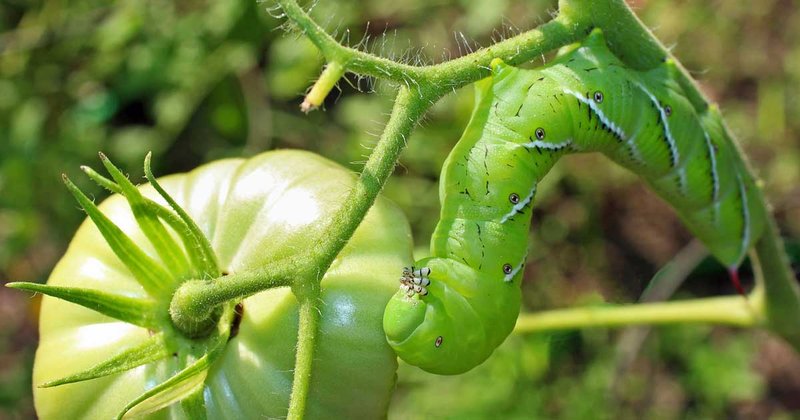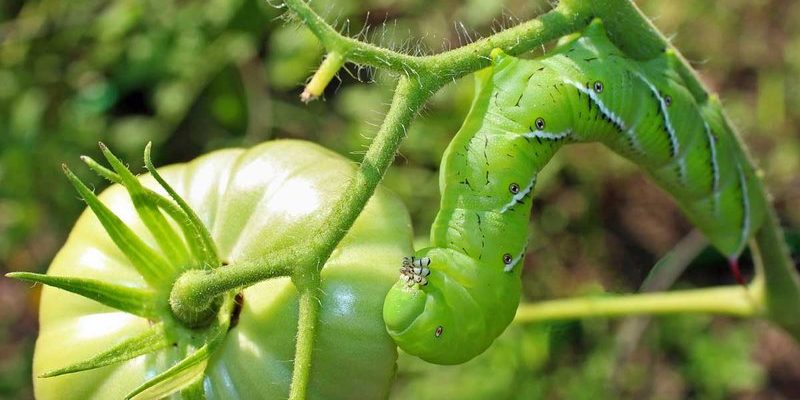
Picture this: you’re enjoying a sunny afternoon, looking forward to the juicy tomatoes you’ve been tending to all season. You spot a few leaves that look like they’ve been through a shredder. At first, it might not click, but that’s when you realize it’s a hornworm party! Understanding how to identify these little monsters can save your garden and turn your green thumb from stressed to success. So, let’s dive into it!
What Are Tomato Hornworms?
Tomato hornworms, or **Manduca quinquemaculata**, are the larvae of the five-spotted hawk moth. These caterpillars are typically bright green, making them blend in effortlessly with tomato plants. They can grow to about 4 inches long, which is pretty hefty considering their impact. Imagine a green giant munching through your plants; that’s basically what these guys do. They’re most active during warm months, especially in late summer, and can consume a staggering amount of foliage in a single day!
The adult moths that emerge from these hornworms are large and sometimes mistaken for hummingbirds. They fly at night and are mostly harmless. However, it’s their larval stage that you need to watch out for. With the right conditions, a few hornworms can quickly turn into a full-blown infestation. So, knowing what to look for is key.
Signs of Tomato Hornworm Infestation
Identifying tomato hornworms isn’t always straightforward, but there are clear signs to look out for. First, the most obvious indicator is sudden leaf damage. If you notice bite marks or entire leaves missing overnight, it’s time to take a closer look. Believe me, it’s alarming how quickly they can devour a plant!
Additionally, you might spot **droppings**. Yes, caterpillar poop, often referred to as frass, looks like small black pellets scattered around your plants. Check under the leaves where these little pests like to hide. Even if you can’t spot the hornworms right away, the droppings can give them away.
Also, keep an eye out for the **horn** itself. Hornworms get their name from the horn-like projection on their rear end. If you see a caterpillar with a little horn, you’ve found yourself a hornworm. They can sometimes be mistaken for other caterpillars, so pay attention to that distinctive feature.
How to Find Tomato Hornworms
Now that you know what to look for, let’s talk about how to actually find these sneaky pests in your garden. Start by inspecting your plants regularly. It’s best to go out in the morning or late evening when they’re most active. You want to be thorough; check both the tops and undersides of the leaves. Hornworms are experts at hiding!
Another tip is to use your senses! If you see bits of foliage missing or notice an odd, almost eerie silence in your garden, it could mean there’s a party happening under your leaves. Sometimes, you can even hear them munching. Yep, it’s a bit creepy, but it’s a sign that you need to take action.
If you’re struggling to find them, consider using a **flashlight** at night. Those active, large caterpillars will be easier to see when it’s dark. Just be careful not to accidentally scare off beneficial insects that might be working hard to help your garden.
What to Do Once You’ve Identified Them
So, you’ve spotted the tomato hornworms. Now what? It’s essential to act quickly to minimize the damage. Here are some tried-and-true methods to handle them:
- Handpicking: This method sounds simple, and it is! Wear gloves if you want, but it’s perfectly fine to grab them with your hands. Just drop them into a bucket of soapy water to dispose of them.
- Beneficial insects: Encourage natural predators like ladybugs or parasitic wasps, which can help keep hornworm populations down. These allies can be a gardener’s best friend.
- Insecticidal soap: If the infestation is severe, consider using organic insecticidal soap. Spray it directly onto the hornworms, and it will suffocate them.
Let’s be honest—nobody wants to see their tomato plants devastated, but by keeping a close eye on the situation, you can intervene before it’s too late.
Preventing Future Infestations
Once you’ve dealt with the current hornworm issue, you probably want to ensure they don’t come back. Prevention is key. Here are some handy tips to keep your garden safe:
- Rotate your crops: Each year, try planting your tomatoes in a different spot. This disrupts the hornworm life cycle and makes it harder for them to find their favorite food.
- Use companion planting: Consider planting herbs and flowers that deter hornworms, like basil or marigolds. They not only add beauty to your garden but can help protect your plants!
- Regular inspections: Make it a habit to check your plants regularly, even when you don’t suspect a problem. Early detection means you can address it before it becomes an issue.
Remember, a little vigilance goes a long way in keeping your garden thriving.
When to Seek Professional Help
Sometimes, despite your best efforts, the hornworms might be too many to handle alone. If you find yourself overwhelmed, don’t hesitate to seek out professional pest control services. They can provide advanced methods and treatments that are often more effective for severe infestations.
Moreover, if you’re unsure about the right steps or products to use, a local garden center can offer guidance tailored to your specific situation. Getting expert advice can save your garden from becoming an all-you-can-eat buffet for hornworms.
Identifying tomato hornworms in your vegetable garden may feel daunting at first, but with the right knowledge and tools, you can keep your plants healthy and thriving. Keep your eyes peeled for the signs, act quickly when you notice them, and use preventive measures to protect your garden for the future.
Cultivating a garden is truly a labor of love, and knowing how to manage pests like hornworms is just one piece of the puzzle. With a little patience and care, you’ll be on your way to enjoying a bountiful harvest of delicious tomatoes—all while keeping those pesky hornworms at bay! Happy gardening!

